
IRIS login | Reed College home Volume 91, No. 4: December 2012
Rediscovering Lloyd Reynolds (continued)
Part two begins with a quote from the British scribe Alfred Fairbank, “The line and shape of Italic is an expression of movement,” and then presents Reynolds’ profound teaching about italic handwriting and calligraphy as vital rhythmic movement. As in part one, Reynolds’ running commentary addresses his readers, the teachers, as though he is present preparing them gently but thoroughly to work with their students.
The manuscript was finally published by Alcuin Press in 2011. We here present some excerpts.
On Free Hand
In making the transition from set hand to free hand it is of the utmost importance that the student have the proper understanding of what is involved. If he concentrates upon speed, he will waste time and effort. Two other considerations are much more effective: (1) the student must persist at all times in writing Italic, and (2) he must concentrate on making the elliptical shoulders to h,m, and n. If he writes only Italic, the pressure of circumstances will force him to write as fast as the limit which is safe for h,m, and n.
At the beginning of the transition the teacher’s main concern is with three psychological impediments: (1) the student’s fear of losing the letter-form when he accelerates, (2) his growing lack of self-confidence and his discouragement, and (3) the spasm, or cramping of the fingers and hand, which is intensified during this period.
The student who can write Italic rather well with his eyes closed (except for connections in two-stroke letters, unevenness of line, etc.) has demonstrated something far more important than he realizes. He has advanced considerably in the craft by showing that he is beginning to ‘get the feel of it.’ This is of basic importance . . . It is a kind of knowledge which his body and especially his hand is acquiring
Peripheral vision
The purpose of training one’s awareness of peripheral vision, at this time, is to develop kinetic imagery, so that the hand may be freed from the strict supervision of the mind and of central vision. The next exercises are designed to accustom one to a reliance on kinetic imagery . . .
One’s natural writing size will be revealed by blind writing. Lay most stress, however, on the student’s watching the sensation in his own hand. This will improve his feeling for the tools and materials and his feeling for the movement which creates good form.
How Fast is Too Fast?
The musician or athlete just does what he has to do without special thought or eye-control. He experiences a ‘mass of undifferentiated sensations that make one aware of the body and its condition’, an experience called ‘coenesthesis’ by the psychologist. This general awareness, with the writer thinking only of the words, is the integrated state which is our goal.
Let it be stressed: the purpose is to build better kinetic images; speed must be looked upon as incidental. The student is to develop his maximum safe-writing speed, not just speed.
When the student hears the word he is to visualize it as a form. He should make the joins as a continuous gesture.
Rhythm
Before he can go ahead he needs further discipline. First he must learn to write at a regular, even pace, in a rhythm with a regular beat . . . if he is to write with ease any passage of poetry or prose that requires a little sustained effort.
In writing a long prose quotation, the work is less tiring and proceeds more rapidly if the pen moves in a sustained regular beat. The pen movement is, in effect, continuous, flowing rather than metronymic.
Chancery & Free Calligraphy
No one should try Chancery Cursive capitals who still has difficulty with the proportions of the set capitals . . . Not only must the proportions be inoffensive, but the curves full, the straights really straight and the horizontals firm. Swash (flourished) capitals demand split-second timing by the writer. Balanced constructions are absolutely imperative.
Once the student has thoroughly learned all these safe constructions— learned them so well that he has them ‘in his fist’, and can produce them rapidly and spontaneously without prior deliberation, he is prepared to make his first attempts at free calligraphy. The quintessence of free calligraphy is its swift, spontaneous rhythmical movement, which builds a single vigorous form out of a word or phrase.
Free rhythm
Take a few minutes to speak of movement as gestures . . . Crystals, fir trees, volcanic peas, stream courses, reeds – each has a form, a direction of movement, a particular kind of thrust into space, which is the visible and distinguishable manifestation of an impulse. . . . As in earlier dictation exercises, the student learned to experience joined sequences of letters as continuous, unified rhythmical impulses, he now can try seeing the word and phrase as a total, unified gesture. Watch the impulse coming to the hand—the impulse that is both the meaning of the word or phrase and at the same time its unified graphic shape.
Letters as expressive forms
Any page of printing has a gesture, a stance. The stance of each letter is in harmony with the stance of the page. Most of us never see it consciously, but students of the letter-arts must learn to look closely and to be aware of what they are seeing. A letter form is always more than an abstract symbol for a sound, it is also an expressive gesture.
Typography
A skilled typographer also knows how to arrange the type he has chosen in an appropriate total design (layout) so that this gesture will have its maximum effect. Type face and layout, integrated, are a total form, a complex harmonious gesture that has meaning in itself.
The student of the letter arts must pursue the question of how the form (gesture) of a particular type face relates historically to the culture which produced it.
As craftsmen, we must learn to look kinetically and to see intuitively. Just as important, we must make the study of cultural history one of our favorite preoccupations.
Italic as expressive form
What can be said of the gesture of Italic? First, I shall risk an incomplete and overly simplified summary of the positive characteristics of the Renaissance humanists: a love of classicism, of order, proportion, symmetry, and harmony and interest in humanity and faith in its potentialities, a devotion to ideals of scholarship, a respect for calligraphy, a feeling for tools and materials and an insistence on proper technique in using them, and an intense interest in the problem of how to lead the good life . . . But what of our modernized form of Chancery Cursive, the Italic: does it express in its gestures any qualities of human dignity and grace? Unquestionably it does have dignity, proportion, harmony, human warmth, and a beauty surpassing that of any other cursive handwriting style. I believe that it is something of this feeling about Italic that draws people to it today.
Rhythm and meaning
If one is acutely aware of word meanings, of their denotations and connotations, and is responsive to nuances of rhythmical movement, he is often able to interpret a particular word or phrase by the rhythmical movement of his pen, provided he has the technical training and the experience. As the inflections, tone, pitch, speed, volume, emphasis, etc., of a living voice make a word a vital expression, so may rhythmical movement of the pen provide an equivalent when the word is committed to a writing surface . . . .
If written skillfully in free rhythm, words look like what they say. It is far more important, however, that they move in the manner signified by the words.
A letter is a letter, not a picture of anything. It is not a picture of rhythmic movement; it is rhythmic movement.
- Previous Page
- 1
- 2
- Next Page
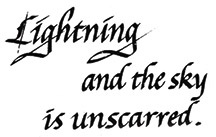
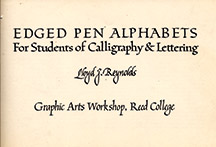
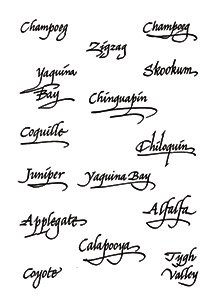
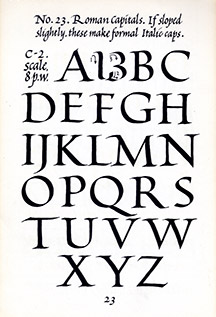
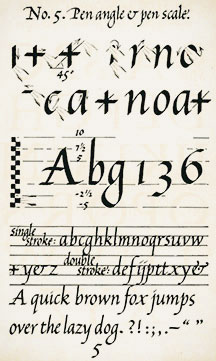
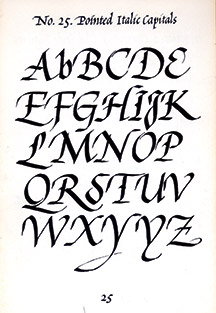
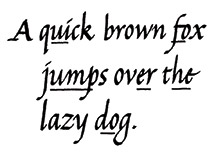
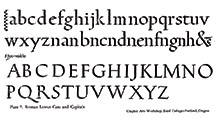
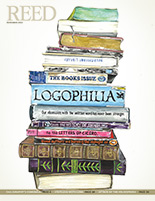

LATEST COMMENTS
steve-jobs-1976 I knew Steve Jobs when he was on the second floor of Quincy. (Fall...
Utnapishtim - 2 weeks ago
Prof. Mason Drukman [political science 1964–70] This is gold, pure gold. God bless, Prof. Drukman.
puredog - 1 month ago
virginia-davis-1965 Such a good friend & compatriot in the day of Satyricon...
czarchasm - 4 months ago
John Peara Baba 1990 John died of a broken heart from losing his mom and then his...
kodachrome - 7 months ago
Carol Sawyer 1962 Who wrote this obit? I'm writing something about Carol Sawyer...
MsLaurie Pepper - 8 months ago
William W. Wissman MAT 1969 ...and THREE sisters. Sabra, the oldest, Mary, the middle, and...
riclf - 10 months ago